



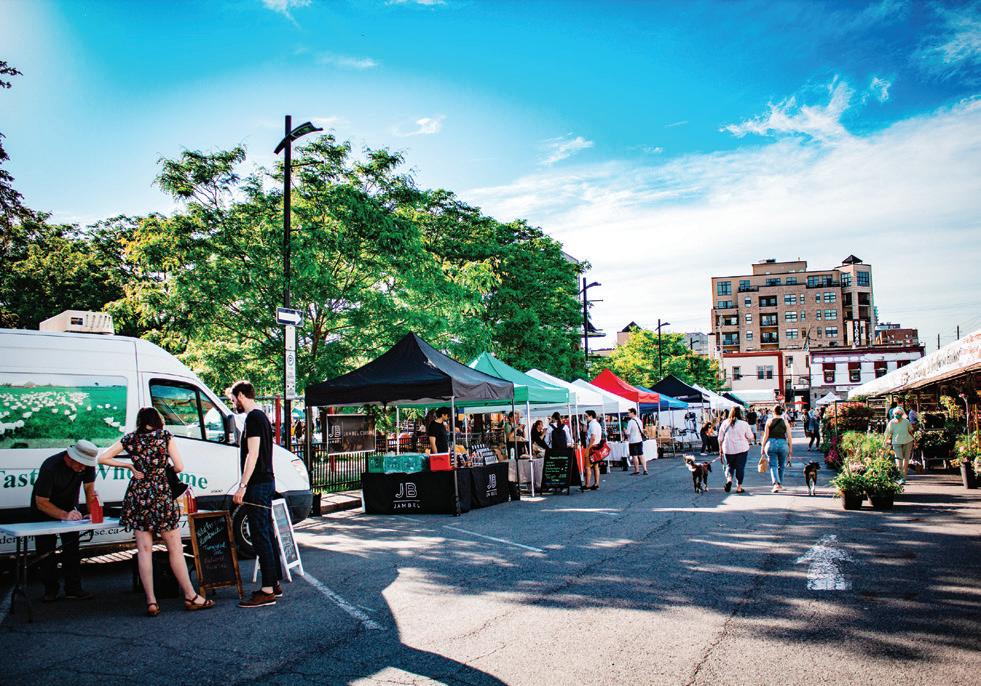





• Centennial season events calendar
• Historical timeline of the market
• Produce availability guide
• Business feature: Robinson Greenhouses
• Parkdale Night Market calendar
















• Centennial season events calendar
• Historical timeline of the market
• Produce availability guide
• Business feature: Robinson Greenhouses
• Parkdale Night Market calendar





This July, the historic Parkdale Public Market is celebrating 100 years of gathering the community together. Established in 1924, the market opens every year from May to October and offers Ottawa residents a wide selection of produce, flowers, and plants from both local and Canadian suppliers.
The tradition began on July 9th, 1924, when the city clerk published a notice in the evening paper: “Those interested in the establishment of a West End Market on Parkdale Avenue North of Wellington Street are hereby notified that the market will be open for business tomorrow morning, Thursday the 10th.” The next morning, weightmaster Louis Charbonneau opened the operator’s building to greet a crowd of over 200 shoppers looking to purchase produce from local farmers.

Except there wasn’t a single farmer to be seen! Bad weather and a late announcement conspired into a mix-up still remembered 100 years later. Thankfully, prospective shoppers took the mix-up with good humour and came back the next Saturday. By 1930, the market had firmly established itself as an affordable alternative to overpriced grocery stores.
“In an era where grocery prices are wildly out of pace with many family’s incomes, and big grocery chains hold so much power over the food we eat, neighbours coming together to buy local food and support their community’s businesses feels very special,” said Tina Barton, Parkdale Centennial Coordinator and owneroperator of Hungry Babe. “In the past, Parkdale

Public Market was home to predominantly family farmers–just as Ontario was home to an abundance of familyoperated farms. While every small farm closing in our region is a tragic loss to the community, a vibrant public market is made up of more than just local produce. We’re proud to see small businesses of all kinds, owned by people from all walks of life, thrive in our market.”
The Parkdale Public Market continues to grow year over year, defying the thought that it needs saving. In 2018, the ByWard Market District Authority (BMDA) took over managing both the ByWard and Parkdale Public Markets, and one of its first moves was to open the Parkdale Night Market.
“It was extraordinary to witness. A community emerging from their homes and showing up, baskets in hand, to say: we needed this, we support you, we feel safe here. The Night Market is still our most popular event at Parkdale Public Market, and we’re often asked why it took off the way it did,” said BMDA Executive Director, Zachary Dayler. “The truth is that we couldn’t have predicted how much being at Parkdale mattered to people in those difficult times and how what we established then would still feel significant to them now. The night market event represents everything that is so extraordinary about Parkdale.”
The Parkdale Public Market is a cornerstone of the west-end community, serving as a gathering place and exchange-place. Whether for your daily grocery run, a weekly ritual, or as a pickup spot for Community Supported Agriculture (CSA) programs, the market solidifies its commitment to sustainability and community support. With the community’s support, hopefully the Market will continue to expand for another hundred years.
“In 2124, whatever the landscape of the Parkdale Public Market looks like, I hope the residents who live there or just simply visit there love local food and love their neighbours,” said Dayler. “I do think the tradition of the market will continue to look a lot like it looks now; food shared with friends, a free concert in the park, a friendly meeting at the market stalls. I hope those people in the future continue to come together in their community to celebrate the special days and the regular days. What happens at Parkdale Public Market today, and every day of the last century, is what people do best - connecting with the land, their food, and their community.”
The Parkdale Public Market operates from seven days a week from 9 a.m. to 5 p.m., May to October, at 366 Parkdale Ave. The Night Market extends that to 9 p.m. on Wednesdays.
To secure a vendor space or check out the latest events, visit parkdalepublicmarket.ca













When Mediterranean food lovers walk into Shawarma Al Mouna in Wellington West, they are greeted by a feeling of hospitality.
The tiled floors were installed and sky blue walls painted by owner Mohamad El Merhabik, who designed the space himself. Even the tables and chairs were built and crafted by his hands.
El Merhabik has been in the shawarmamaking business for over 20 years. But it hasn’t always been easy. His more recent endeavor before this restaurant was in Portage in Gatineau, but that chapter ended when the COVID-19 pandemic forced people to stop working in government office buildings.
“I feel so sad when I remember those days. I lost all of my money there; I lost everything there. The government said they helped us but we didn't get help. It was a loan, it wasn’t money,” said El Merhabik. “Those days we sold maybe only $50 to $100, but I wanted to keep my business. I kept it going for maybe four or five months, then the government decided to terminate my lease.”

He had to vacate the space in 90 days. Thinking of his two kids under 10, El Merhabik decided to give it another go in Wellington West.
“I’ve been in business for a long time. It’s hard for me to start working for somebody else. I decided to take a risk again and start building myself. I got my money from my brother, and then I started again,” the shawarma maker said. “I gave myself a chance.”
That chance has so far paid off. Shawarma Al Mouna has seen a steady flow of customers since opening a year ago. About eight staff work for the restaurant, but El Merhabik said he would be slow to grow.
Expansion would one day happen he said, but first El Merhabik would want to introduce delivery.
“Every month I want to start but I can’t because we are getting more busy. I want to keep the quality of the food,” he said. “Uber keeps contacting me to start with them. It’s not just about money; It’s about quality. We are thinking for the long term.”
It’s difficult to pinpoint when exactly the shawarma trend started; however its popularity outside of the Middle East began in the mid 1990s and early 2000s.
Many believe the fast food dish first started in Ottawa with Marroush, which opened on Elgin Street between Gladstone and Frank in 1984. El Merhabik opened a Shawarma shop with his brother under the same name at Rideau and Dalhousie in 2005. They sold it off a few years later.
During a city council meeting in April, Ottawa was declared the Shawarma Capital of Canada after a motion was put forward by Innes ward councillor Laura Dudas. She told KT the intent was to help boost Ottawa on the global map.
“I looked at this as an opportunity to highlight something that is unique and interesting to our city. Ottawa is very diverse and we don't always promote that in Canada and the world,” she said.
The numbers don’t underestimate the importance of shawarma in Ottawa. There are more restaurants that sell the Mediterranean dish than there are Tim Hortons, McDonalds, or even gas stations.
Dudas said she received a letter from the ambassador to Lebanon who appreciated the initiative, and said he's interested in starting a new Shawarma festival in the Nation’s Capital.
“These Shawarma shops, the vast majority, are owned by local people, people who are newcomers to our city in many cases,” said Dudas. “They are buying up local produce and hiring local workers. They are driving the economy in the tens of millions of dollars.”









Jan
|1:00-4:00pm
NewYear Celebratethe Chinese NewYear at our open house.The Success Dragon Lion DanceTroupe performs at 2pmand will have aluckydrawfor agift. TheChinese Lion Danceisa3000-year-old Chinese tradition thatsymbolizes prosperity,luck, and happiness. Taiyaki-style desserts and refreshments will be served.







KT’s newsletter keeps readers up-to-date and informed
SIGN UP TODAY

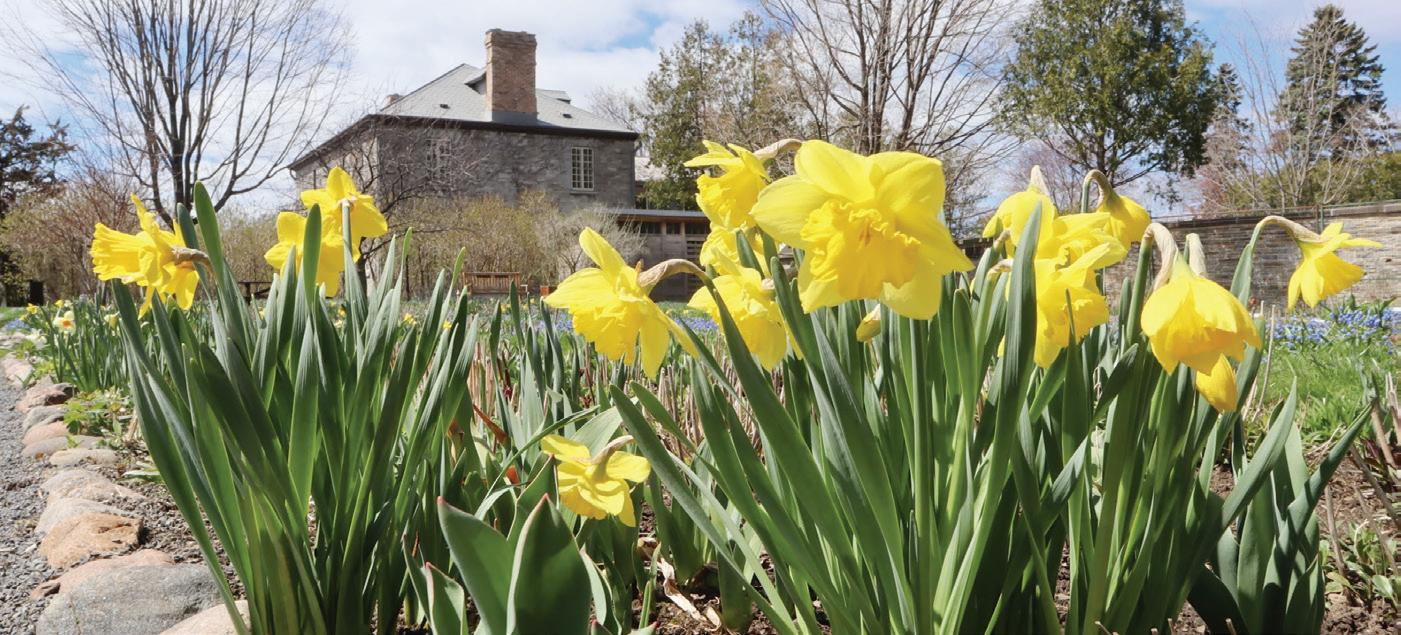
INTERESTED IN THE DEMOCRATIC PROCESS?
THINK
If we want municipal, provincial and federal election debates in Kitchissippi to continue into the future, our community working group needs new volunteers. There are some very small tasks and also much bigger roles — YOU choose how you contribute to the team. Whether you want to help lead the debate working group or simply help on the day of the debates, there are opportunities for you.

It takes about six weeks to organize a debate, so the commitment is in short windows when elections are called. However, it’s important to get some planning done ahead of time so that the team is ready when an election is called. We are looking to have new volunteers in place ahead of the federal, provincial and municipal elections in 2025–2026 (or earlier).
Tasks include event planning, volunteer coordination, sound tech, live streaming, promotion/communication, sourcing venues, timekeeping, and question development.
Want to help or interested in learning more? Email newsletter@hamptoniona.
family. Discover how to use iNaturalist to help identify plants and insects, help create a decorative border to protect the plants, make a pollinator hotel for your yard, learn about essential links between monarch butterflies and milkweed plants, and, while supplies last, take home some seeds to plant in your home garden. Don't miss this chance to connect with nature in our neighbourhood!
START CLEARING YOUR CLOSETS, BASEMENTS, AND GARAGES: THE KITCHISSIPPI YARD SALEJUNE 1 AT 8:00 A.M.: Throughout Kitchissippi there will be yard sales happening galore and we encourage you to participate! Start pulling together your items and get your sale added to the google map by emailing jeff.leiper@ottawa.ca with your address. See the full map at tinyurl. com/yard-sale-map
Want to get rid of stuff without running a sale? Put items out on June 1 with a “FREE” sign! Interested in adding to the community fun? Kids can run lemonade stands, musicians can play on porches, and more!
KITCHISSIPPI TIMES
Great River Media Inc
PO Box 91585
Ottawa ON K1W 1K0
Kitchissippi, “meaning great river” is the former Algonquin name for the Ottawa River. The name now identifies the urban community to the west of downtown Ottawa.
EDITOR
Charlie Senack
editor@kitchissippi.com twitter.com/kitchissippi twitter.com/charlie_senack
CONTRIBUTORS
Hannah Wanamaker, Christina Korotkov, Daria Maystruk, Devon Tredinnick, Mat Dicsi and Dave Allston.
PROOFREADER
Susan Rothery
ADVERTISING SALES
Eric Dupuis 613-696-9485 eric@kitchissippi.com
CREATIVE DIRECTOR
Tanya Connolly-Holmes creative@greatriver.ca
GRAPHIC DESIGNERS
ca. This initiative involves all community associations in Kitchissippi.
Construction is a constant reality in Hintonburg! Renovations and new building development can often result in road and sidewalk encroachment, damage to asphalt/curbs, increased truck traffic, noise issues and more. Most recently the Hintonburg Community Association (together with local school and political authorities) supported Devonshire Public School as students were at risk of harm from local construction. We have also created a Builders Code of Conduct that we provide to all developers. Please report unsafe situations to info@hintonburg.com. Together we can address construction safety issues in Hintonburg!
CELEBRATING LOCAL PLANTS
AND POLLINATORS - MAY 25, 10:30 A.M. TO 12:30 P.M. AT PRINCESS MARGRIET PARK:
Join the Civic Hospital Neighbourhood Association for a fun spring morning exploring our Native Plant Demonstration Garden! Enjoy activities for the whole
Want to help a great cause? Consider donating your proceeds to a local charity! This event includes participation from all Kitchissippi community associations with the exception of Westboro – they are running their own event the following week.
THE WILD, WILD WESTBORO
GARAGE SALE IS BACK - JUNE 8, 8:00 A.M. TO 12:00 P.M.: Multi-family garage sale at Dovercourt! Gift basket raffle! Great deals you’ll be happy to find! Got stuff to sell? Reserve your table now for $15 +tax. Tables and locations are available on a first-come/first-served basis. Please, no baked goods. There is no rain date. The Wild, Wild WESTboro Garage Sale is brought to you by the Westboro Community Association and hosted by Dovercourt. All proceeds go to the Westboro Community Association which supports projects that benefit our community.
After four long years, Mechanicsville Day returns on June 8th to celebrate the 150th Anniversary of Mechanicsville! There will be cake, sports and children's activities! This event will be held at Laroche Park. If you would like to help or sponsor an activity, please send a message to MechanicsvilleCA@gmail.com.
Celine Paquette celine@greatriver.ca
Deborah Ekuma deborah@obj.ca
FINANCE
Cheryl Schunk, 613-696-9490 cheryl@greatriver.ca
All other enquiries 613-696-9494 info@kitchissippi.com
DISTRIBUTION
A minimum of 15,000 copies are distributed from the Ottawa River to Carling Avenue between the O-Train tracks and Sherbourne Road. Most residents in this area will receive the Kitchissippi Times directly to their door. If you did not receive your copy, or would like additional copies, please contact us. Bulk copies are delivered to multi-unit dwellings and retail locations. Copies are available at Dovercourt Recreation Centre and Hintonburg Community Centre.
DISTRIBUTOR
Comet 2000
info@kitchissippi.com
The Kitchissippi Times is published by

FOUNDER
They say April showers bring May flowers, and we can hope that is true as the annual Tulip Festival is about to get underway.
May is one of my favourite months. It’s a time when the weather gets warmer, signs of life start sprouting from the ground, and smiles return to people’s faces as they come out of winter hibernation. I suppose we got an early start this year, regardless.
In this issue of KT, I share the story of an old Indian burial ground that was discovered on Aylmer island. Despite its name, the secluded spot is actually part of Bay ward. I also sat down with the owner of Wellington West’s Bagelshop which is gearing up to celebrate its 40th anniversary.
which has added a new flavour to the Village’s Main Street.
It’s been almost seven years since Abdirahman Abdi was killed outside his Hilda Street apartment. Christina Korotkov has details of a new inquest that has been launched into his death.
Devin Tredinnick caught up with Canada’s Topflight Basketball Academy, which runs out of Notre Dame High School. You can read about why the group is lifechanging and lifesaving.

Ottawa has been declared the shawarma capital of Canada after city council passed a motion last month. I visited Al Mouna which has been serving up Mediterranean food in Kitchissippi for the past year.
For our ‘Giving’ feature, Hannah Wanamaker visited with the Ottawa Modern Quilt Guild which is gearing up for an event at Bayview Yards in early June. Hannah also has the latest on paid parking which is almost certainly coming to Westboro and Wellington West. Reactions are mixed.
Daria Maystruk reports on the Westboro Beach redevelopment which has been delayed again. Beachgoers will still have the chance to sunbathe on the sandy beach area without supervision.
In ‘Humans’, Mat Dicsi spoke with Jeff McIntyre, a Westboro resident who recently published a new graphic novel that is accessible for all. And on the topic of reading, Mat also visited Westboro Books
OPEN FOR REGISTRATION:
• Spring 2 swim lessons (session runs Apr 27 – Jun 28)
• Spring recreation programs start May 6, including soccer, tennis, skateboarding, baking, pottery, and more
• May & June recreation workshops: crafts, tap dance, biking, jazz, tennis & more
• Summer Camps & summer swim lessons
• PD Days for June; Afterschool program for 2024-2025
UPCOMING REGISTRATIONS:
• Summer Fitness - June 4
• Fall Recreation & Swim Lessons - June 18
In ‘Early Days.’ Dave Allston writes about Kitchissippi’s long standing history with pool halls, which is quite scandalous. You can find out more about why they were banned and the community uproar which was started.
A quick note to our readers: You may have noticed that KT has been expanding our territory to the outer boundaries of our catchment zone. After celebrating our 20th anniversary last November, we are excited to keep evolving. Community news has never been as important as it is now, especially with the latest cutbacks in mainstream media.
You will start to notice more coverage coming out of Bay ward as far as Britannia, and some in Little Italy as well. For the June issue of KT, we plan to report on the rich culture of Preston Street as it gears up for the annual Italian Festival.
If you haven’t already, please sign up for our regular newsletter on Kitchissippi.com. We have now upped our online circulation to four times per month. Stay up to date on our website for all the latest community news as it happens. And if you have any story ideas, please send me an email at editor@kitchissippi.com.
Happy reading!
SUMMER CAMP & SWIM LESSONS
This year’s lineup is incredible! Theme Camps, Adventure
Overnight, Band, Flag Rugby, Baseball, Acrobatic Jump Rope, Fashion & Jewelry Design, Circus Performers and more!
Swim lessons are available once a week or 5 days in a row.

The best value and most fun! 40+/ week classes including group fit, spin, and aquafit classes, fitness centre, pickleball and pool access. Starting at $46/ month.
Register for spring PD Days: June 3, June 7, and June 21
Friday Date nights: May 24 & June 14
Save the date: The Wild Westboro Garage Sale, presented by the WCA, is Sat. June 8, 8am-12pm at Dovercourt. There are still tables available to book for sellers.





For decades Aylmer island has been a hangout spot for families, kayakers, and party-goer teens. Over the generations, stories have been passed down about ancient Indian bones buried at the site.

When Rick Henderson was only a little kid, he discovered the urban legends were true.
“I was an eight-year-old boy. My father was an avid boater and he knew a lot about the history of the area,” Henderson recalled to KT. “It was only a rumor that Alymer island was an ancient burial ground until one summer day when his friend Pierre Normandin led us in his boat and he was going to show us where the bones were. It was fascinating.”
Henderson said Normandin, a local CBC producer, had been to the island before and reburied the bones he previously discovered.
How the bones got there and how old they are remains a mystery. Some experts
state they could be upwards of 4,000 years old. The long forgotten story was unearthed for the first time in over a century last month when historian Andrew King, a former Westboro resident, wrote about it on his blog at ottawarewind.com.
Knowledge of bones being on the island was first published in the late 1890s by Thomas Walter Edwin Sowter, who, according to the Canadian Museum of History, was the Ottawa Valley's first archaeologist.
His discovery of the human remains came as a result of the Alymer lighthouse construction in 1883. The island is about an acre in size and is situated about a kilometer from the Ottawa shoreline.
“I have assisted at the exhumation of several skeletons, which has given me a fairly accurate insight into the mode of sepulture which obtained among the aboriginal people of Lake Deschênes,” Sowter wrote. “There is abundant evidence to show that
“The custom of burying their dead involved the disinterment of deceased relatives from their initial individual graves followed by their reburial in a final communal grave,” wrote King. “This ritual was both for mourning and celebration, and was documented by the Jesuit missionary Jean de Brébeuf who was invited in the spring of 1636 to a large Feast of the Dead on a beach near Midland, Ontario.”
It was common for reburials to take place every 10 years or so, with the bones sometimes being transported far away from their original resting places.
What’s not understood, however, is why the Huron would be on Alymer Island when there is no documented proof of their people residing near the Ottawa River.
Sowter speculated the Huron may have been given sanctuary by the Algonquin First Nations after they were defeated in other regions.
A two pound iron axe, a knife with an intricate inlaid copper vine motif on its handle, a bone harpoon, a copper kettle with an iron handle, and human hair wrapped in birch bark were also unearthed for the first time in centuries. A Toronto archeologist by the name of David Boyle said the items were of European descent.
There was also a stone slab with “JPOT” inscribed into it, which was perhaps a grave marker.
the island has been used as a burial place from very early times down to a period so comparatively recent as to come within the memory of those of the generation that is now passing away."
According to the archeologist’s report, a wagon full of bones and artifacts were discovered in various places around the island. Among the peculiar finds was the skeleton of an individual found buried in a reclined seated position. Further examinations determined the individual was killed by an arrow that entered his lower back.
Sowter said the burials were strange as they did not align with known Indigenous practices and rituals in the area. Most Indigenous bodies were buried in a prostrate position, he said.
According to King’s reporting, the remains might be from the Huron people. They had an ancient tradition called “the feast of the dead.” The Wyandot people, as they were called, resided in central Ontario.
It’s unclear what has happened to the bones and artifacts taken off the island, but at least some remain there today. Henderson said he’s heard of a few people who unintentionally came across them over the years.
“Four years ago, a friend’s 14-year-old son and his friends were there for his birthday party. They came upon several bones. She was pretty well aware that they were likely ancient, but she didn’t know what to do so she called me,” he said.
“She called the OPP and I took charge of notifying the two reserves — the Kitigan Zibi Anishinabeg Cultural Centre and the Algonquins of Pikwakanagan Council.”
Police confirmed the bones were old, and said it was up to the Indigenous communities over how to proceed. To date, no action has been taken.
Verna McGregor, an elder and cultural spokesperson in the Algonquin community, said she’d like to see the site be protected.

“The bones have just been disregarded; they were there for a reason. There were probably artifacts with the remains too, and sometimes they get picked over and that’s very disrespectful,” McGregor told KT. “I think there still needs to be a full consultation process over what happens when something of major historical significance happens at a place like Aylmer Island. Like everybody else’s remains, we’d like to have them protected.”
McGregor said the island is a sacred place that can be used to teach future
generations about the racism and misrepresentation Indigenous people have faced in Canada for centuries.
“We were known as the river people. Our method of travel was the birch bark canoe. It was common practice to bury our ancestors along the Ottawa river,” she said. “It would be a good idea to gather people out of respect, but also for reconnection to our lands.”
Despite its name, Alymer island is actually located in Bay ward on the Ottawa side of the river. Area councillor Theresa

Kavanagh, an avid kayaker who has taken day trips to the site, said she was shocked to read about what’s hidden below the layers of sand and dirt.
Kavanagh said she has plans to connect with the local Indigenous communities to see what kind of memorial can be erected.
“I was blown away. We need to treat it seriously and protect the island. It looks like a lot of partying goes on there and it needs some tender loving care,” said Kavanagh. “But we need to talk to First Nations about that. They need to have a say on what the next steps would be.”
•




The emphasis on improving Ottawa’s active transportation coupled with tough economic pressures has residents clashing over the consequences of implementing paid parking on Westboro and Wellington West's main streets.
A recent study evaluating parkingrelated issues in the two communities conducted by the City of Ottawa found that multiple sectors exceeded the practical capacity of 85 percent occupancy in 2023.
The report sought to optimize parking services, promote sustainable and active transportation, and resolve parking-related issues on main streets and in residential areas. Recommendations based on its findings and community consultations will be presented to the Transportation Committee and City Council this summer.

“We are currently engaged in the final stages of the parking study for Kitchissippi ward and it really focuses on commercial streets,” said area Coun. Jeff Leiper. “We’ve had this discussion a couple of times and we are now at the point where the vetoes that stopped paid parking in the last term of council have been eliminated. No one stakeholder has a veto on whether or not paid parking goes in.”
When a similar parking study took place in 2015, residents demanded that the City keep the meters off Kitchissippi streets. The minimal on-street parking during the pandemic shelved the debate again, but as parking patterns have returned to pre-pandemic levels, Leiper said the only way to manage is by introducing new fees.


The Westboro Village BIA supports paid parking because it can create turnover and create more flexible time limits than the current restriction of 90 minutes, said its executive director Judy Lincoln. This is common
commercial areas like Preston St, Montreal Rd, and Bank St. Leiper said it’s no longer a question of whether paid parking will be approved, but what the rates and pay periods would be.
The city has had a tough few years financially, but the Kitchissippi ward representative said paid parking is not a cash grab but rather an “efficient management of our parking supply.”
Despite Leiper’s inclination toward this solution, Kitchissippi businesses and
community associations don’t see the need.
“Based on my staff’s ability to find parking, and my ability, and talking to the membership, there aren’t a ton of issues here. I know that based on the parking department studies and talking to the public, not many people in our area can’t find parking,” said Devon Armstrong, interim executive director of the Wellington West BIA. “When you look at the Kitchissippi ward as a whole, that changes because Westboro is much more congested.”
Armstrong’s BIA is against higher turnover rates that a levy would promote because they want to work as a cluster, encouraging patrons to visit multiple shops during their visit.
Businesses in the area have faced a turbulent few years because of the pandemic. Stella Luna declared bankruptcy of its Wellington West store earlier this year, and in December, the popular Won Ton House restaurant closed after being in the community since the 1970s. Herb & Spice grocery store served its last customers in July after finding it difficult to compete with the large retailers. In neighboring Westboro, West End Kids declared bankruptcy after owing creditors about $900,000.
There are now concerns over how paid parking could further deter business.
“[We are] firmly of the view that the current arrangement underpins and nourishes the commercial establishments that line these streets and give the various neighbourhoods the ‘village’ flavour that is so greatly appreciated by the locals and visitors alike,” wrote Westboro community association member David Morgan in an email.
Matt Whitehead, chair of the Hintonburg Community Association’s transportation

committee, said the Wellington West strip resembles a 15-minute city where people can walk through the various shops.
As a lifelong resident of the area, he noted there has always been parking available, though sometimes that means looking a few blocks away. He said asking drivers to pay would be a “drastic measure”

and “a solution looking for a problem.”
“How much does it cost for us to install and purchase all of these paid parking machines and implement them, and at what point do we earn back the money that we spent trying to put these things in place so that then we can actually start putting money back into the community?” he asked.
When you look at the Kitchissippi ward as a whole, that changes because Westboro is much more congested. — DEVON ARMSTRONG

TWhen Whitehead raised his concerns in consultation meetings, he said city staff did not have an answer.
Should paid parking be instituted, locals have advocated that the city ensure the spillover into residential streets is not exacerbated.
The study revealed four times more on-street parking availability on Westboro residential streets and six times more on Wellington West’s residential streets.
Community associations have also posed whether LRT expansions and the residential influx over the next several years would alleviate some of the commuting pressures by increasing the number of people arriving on foot. Stage 2 of the Trillium line is slated to open late this summer with Phase 3 of the Confederation line being completed by 2026.
“It makes sense that the Westboro end is so busy because they don’t have an LRT. They don’t have that public transit option to relieve those pressures,” said Armstrong.
Morgan said in his email that as a result of the light rail and rapid community growth, “Westboro, in particular, requires time to mature into the new neighbourhood it is becoming before such a judgment could be made.”
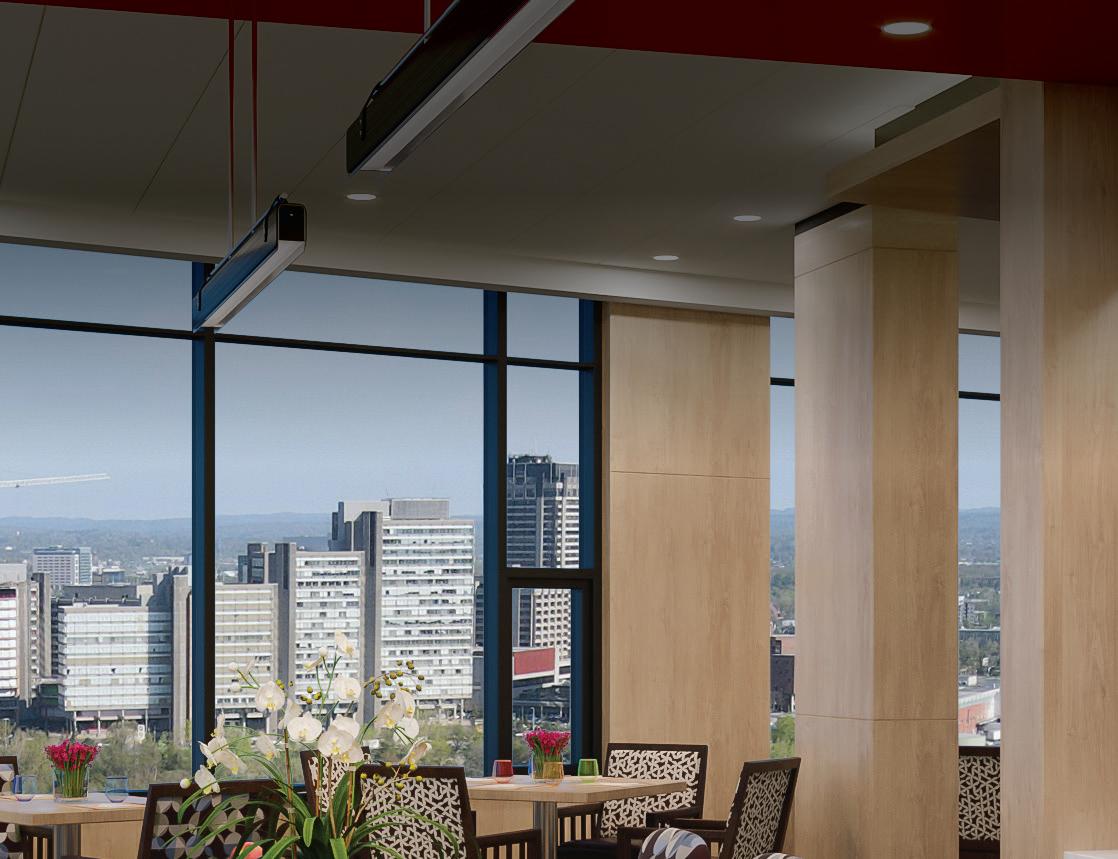







Westboro Beach revitalization delayed again; will partially reopen this summerBY DARIA MAYSTRUK
An unsupervised section of Westboro Beach will open again this summer, with redevelopment efforts delayed again.

The beach has been out of order since June 2022, after the National Capital Commission (NCC) announced the start of its initiative.
The $21-million-project aims to introduce a list of new amenities, including a new zerocarbon pavilion, riverfront lookouts, picnic areas and universally accessible pathways.
It was first delayed in 2022 due to national supply-chain and labour issues, according to the NCC.
Len Fardella, co-president of the Westboro Beach Community Association (WBCA), said the delay was no surprise.
“We all live in this area and it was obvious the beach would not be ready — it was no surprise to anybody,” he said.
While the structural foundations of the pavilion were completed in 2023, the pavilion
and landscaping are left on the NCC’s website’s to-do list for this year. In a report published in January 2024, the NCC noted that landscaping will begin in May.
The stretch that will open this year — about 60 per cent of the beach according to Fardella — was also open last summer.
Many of the amenities will also match what was available last year.

The parking lot will be closed due to ongoing construction along the Kichi Zibi Mikan, but porta-potties and garbage cans will be available.
Swimming will be “at your own risk,” as no lifeguards will be on duty and there will be no water testing.
With the construction “making great progress” at the pavilion, Fardella said the decision to open about 60 per cent of the beach was “a nice
We all live in this area and it was obvious the beach would not be ready — it was no surprise to anybody — Len Fardella
Left: Construction crews work on the pavilion at Westboro Beach on April 22, 2024.
Insert: Len Fardella from the Westboro Beach community association said it’s no surprise plans have been delayed.
PHOTOS BY CHARLIE SENACK..compromise” between the association and the NCC, especially considering last summer’s success.
“What they did last year was warmly received — the beach was actually quite busy over the summer,” Fardella said. “And we were quite happy with the NCC for [the partial reopening], because the default would be just to do nothing … It worked out well last year, and I expect it will work out well this year.”
Fardella said the beach will continue to host events such as a beach closing event in September, which brought in large crowds last year.
He also said the association is now shifting to prioritizing the beach’s accessibility, and plans to follow up with the NCC in May this year about the logistics of the proposed common areas, the redevelopment of a native forest area, as well as the redirection of traffic and parking available to the public.
While Fardella said the association has “crossed fingers” for a full reopening in the summer of 2025, another one of the NCC’s projects — the revitalization of the Maplelawn Garden masonry walls — is still underway.
The walls have deteriorated over time, with another section collapsing in 2021. Other sections of the wall were also at risk.
Collapsed sections have since been fenced off, with the NCC “reusing as much salvaged stone as possible” while dismantling and rebuilding the walls.
Planning and a review occurred in 2021, then tree planting was completed in 2022. The excavation of a trench for the wall foundation, landscaping and the reassembly of the wall is set to be completed by winter 2024.
The NCC was unable to respond with an updated status on the project in time for publication.
The garden continues to be partially open to the public during construction work, which is currently set until Oct. 31, 2024, according to the NCC’s website.
July 10th, 2024
5:00 PM to 9:00 PM
Join us for a lively night market filled with local delights, live music, and cherished memories. Let’s honour the past and toast to a vibrant future together!
FOR HOURS, VENDORS, AND CENTENNIAL SEASON EVENTS:
PARKDALEPUBLICMARKET.CA
FOLLOW US ON:





Block by block and stitch by stitch, Ottawa’s Modern Quilt Guild is embracing spontaneity in a new era of beautiful and iconic quilts.
Modern quilting is a movement that draws on other contemporary art movements like minimalism, solid and bold colours, negative space, and most recently, graphic maximalism. It is a movement of reimagination and individuality.


The Modern Quilt Guild, an international organization with chapters in cities across the world, defines the movement as “a cacophony of size, colour, and shape with not a lot of resting space for your eyes,” said Carlington
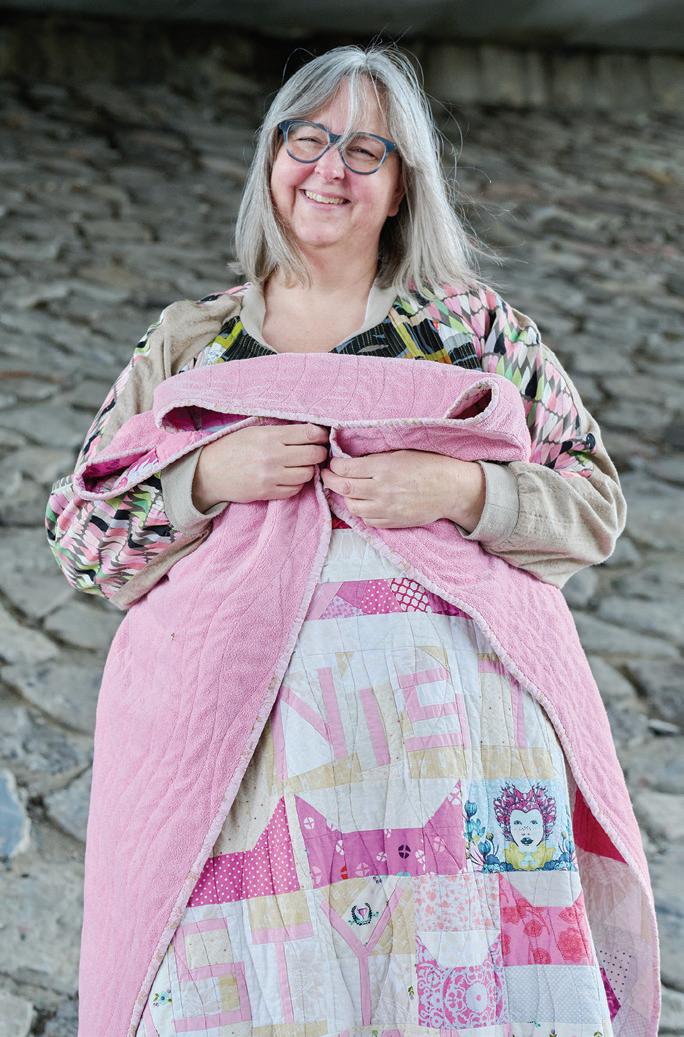
resident Kristin Fearon, who’s been a member of the Guild since it started a decade ago.
The reclamation of traditional, artisan crafts, like quilting, has become increasingly popular alongside sustainable art forms and hands-on skills over the last few years.
After decades of quilting, Fearon said she is currently seeing people “reclaiming craft as an amazing, postapocalyptic skill, as a way of shunning fast fashion and some of the massconsumerization and really bringing back artisan crafts and making things.”
Not only is its comeback stylish, but modern quilting addresses social issues and barriers too.

France Cyrenne said that many quilters are tackling sustainability by recycling fabrics. She often pops by local thrift shops or clothing exchanges looking for used clothing or fabric to use for her projects.
“I like modern [quilting] because I don’t have enough material to do a whole quilt with all matching [patterns],” she said.
Patterned fabric for more traditional styles of quilts can get quite pricey and limit a quilter’s design options. Using scraps keeps fabric out of landfills, adds small details to a quilter’s piece, and repurposes it into something functional and beautiful.
Joel Bekker, another fibre artist who’s been sewing for almost 10 years, says he has never thrown away a scrap of fabric.
Using recycled fabrics is another way Ottawa’s modern guild achieves its mission of promoting the craft and making it more accessible. In the last decade, members have ensured accessible locations to hold meetings, found ways to mitigate financial barriers, and welcomed quilters of all levels and backgrounds.
Modern quilting has seen an influx of its younger population in recent years, which Cyrenne attributes to the style’s dynamism and flexibility.
“These aren’t your grandma’s quilts. I
Left: From left to right: Kristin Fearon, France Cyrenne, and Joel Bekker are all members of Ottawa’s Modern Quilt Guild.
Middle: Fearon’s feminist quilt was worked on by many crafters. Right: Modern quilting puts an emphasis on solid colours.
ALL PHOTOS BY AARON REID.she donates most of her quilts, many of which go to Victoria’s Quilt.
Ottawa’s Modern Guild also gathers to make quilts each year around Truth and Reconciliation Day for survivors of residential schools. Many members donate smaller quilts to Ottawa’s NICUs or to Quilts of Valour, which sends them to returning soldiers and their families.
“We all have this skill and we all want people to feel that hug when the quilt goes around them,” says Fearon.

its member's quilts at Bayview Yards to celebrate its tenth anniversary. They will be featuring a quilt gallery representing eight styles within the modern genre, with artist statements and inspirations next to each piece.
“The Saturday night, I really wanted it geared towards the general public, like people who aren’t quilters,” says Bekker, who has been a central organizer of the event.
They are kicking off the festivities with a catered gala on Saturday, June 1, where guests can preview some of the quilts. This “unique and interesting” experience will include live music from Alanna J. Brown, a cash bar with a signature quiltrelated cocktail from a Bar from Afar, and swag bags for the first 150 people to arrive.
think they’re works of art and they’re bold and beautiful,” she said.
Another part of reclaiming this craft is dismantling the idea of gendered spaces and quilting women’s work. Many modern quilters do this by introducing their craft as an art form that resonates with those who don’t gravitate toward painting or drawing.
“I think social media is helping a lot with popularizing those crafts in the younger folks,” Cyrenne said. “How many TikTok videos have I seen of a guy making these crazy crocheted things or knitting, and that is telling all the young men out there that they should be doing this and it’s okay.”
Community is at the heart of Ottawa’s Modern Guild. During monthly meetings, members learn from each other and socialize with like-minded people while making art.
The notion of community continues beyond meetings and even beyond the crafting process. When a quilt is finished, its artist generally donates it to a Canadian organization or a fundraising auction.
“Everyone who goes through chemo is entitled to a quilt through Victoria’s Quilt, and those quilts have to come from somewhere,” Cyrenne said, adding that
On June 1 and 2, Ottawa’s Modern Quilt Guild will be displaying over 50 of












During the Sunday gallery, guests have the opportunity to see the exhibit and meet some of the featured vendors and quilters.











The Bagelshop and Deli is gearing up to celebrate its 40th anniversary serving customers in the Village. The road to get here, though, was no small task.
The Wellington West eatery was first opened by Vincenzo Piazza in 1984. Unknowingly, he brought a new trend to Ottawa: When he first set up shop, Montrealstyle bagels hadn’t rolled their way into the Capital yet.
“The Bagelshop was actually my mother, Judith's, idea. My father at the time was a teacher,” said owner Liliana Piazza.” My parents went full in, setting a precedent in Ontario law to allow wood-burning ovens, and they created our first shop at only 800 square feet in size — the first of its kind in Ontario.”
It was a family affair. Joe Morena, Vincenzo’s brother-in-law, was already running St. Viateur Bagel in Montreal. He and an experienced team of bagel makers taught the new business owner how to make the traditional bread rolls which originated in the Jewish communities of Poland. Vincenzo was also trained at the Ritz-Carlton in Montreal,
• Ever wonder why bagels have holes in the middle? There is actually a practical reason behind it. The hole also allowed them to be threaded or piled high on a dowel which made them easier to transport and display.
• The biggest bagel ever made weighed 868 pounds.
• Bagels have been to space. Astronaut Greg Chamitoff took
meaning he had a deep understanding of excellent customer service already ingrained inside him.
Montreal-style bagels are hand-rolled, boiled in honey water, and then baked in a wood-burning oven. In contrast to the New York-style bagel, Montreal bagels are smaller, thinner, sweeter and denser, with a larger hole. It contains malt, egg, and no salt.
Liliana fully took over the business from her father in 2019. The second generation owner said she’s a much different owner than her parents, but said she learned a lot from them.
The store expanded twice in the ‘90s and has undergone five major upgrades over the last four decades — the last about four years ago. While its looks have changed, the recipes have always stayed the same. It’s estimated roughly 40 million bagels have been served out of the Wellington West Bagelshop since it first opened.
“We have only ever made our bagels with pantry-staple ingredients, without additives, in our wood-burning oven,” said Liliana. “In this time of increasing unpronounceable chemicals in grocery store food, we are proud to be a place where our customers can feel
eighteen dozen bagels from his aunt's shop up to orbit in 2008.
• Nobody really knows when bagels were invented, but there are two theories: One is they were first made in 1683 as a stirrup-shaped tribute to Polish king Jan Sobieski after he defended Vienna from Turkish conquest. Others suggest they are similar to obwarzanek, a Polish bread that dates back to the late 1300s.
confident that they are feeding good quality, simple food to their families.”
To celebrate its ruby anniversary, the Bagelshop hosted a neighborhood block party on April 27. Mini-bagel sandwiches were served for only $4, balloons and face painting were available for the kids, and a fundraiser collected money for the Make-AWish foundation.
Since its founding, the Bagelshop has always been looking for ways to promote community. Last fall it held a concert series, and earlier this year authors were invited into the space to promote their books. Looking ahead to the next 40 years, Liliana said she hopes to offer up more events like this.

Bagelshop owner Liliana Piazza took over the family business in 2019.
PROVIDED PHOTO.
“It is a great privilege and joy to run this business. It matters to me to maintain its legacy while also introducing new things. There is a balance to growing the business, staying relevant, embracing change, but also maintaining the essence, the quality, the experience that long-time customers have grown to love,” said Liliana. “I learned directly from my parents: be generous, great service is paramount, and delicious food will always sell.”





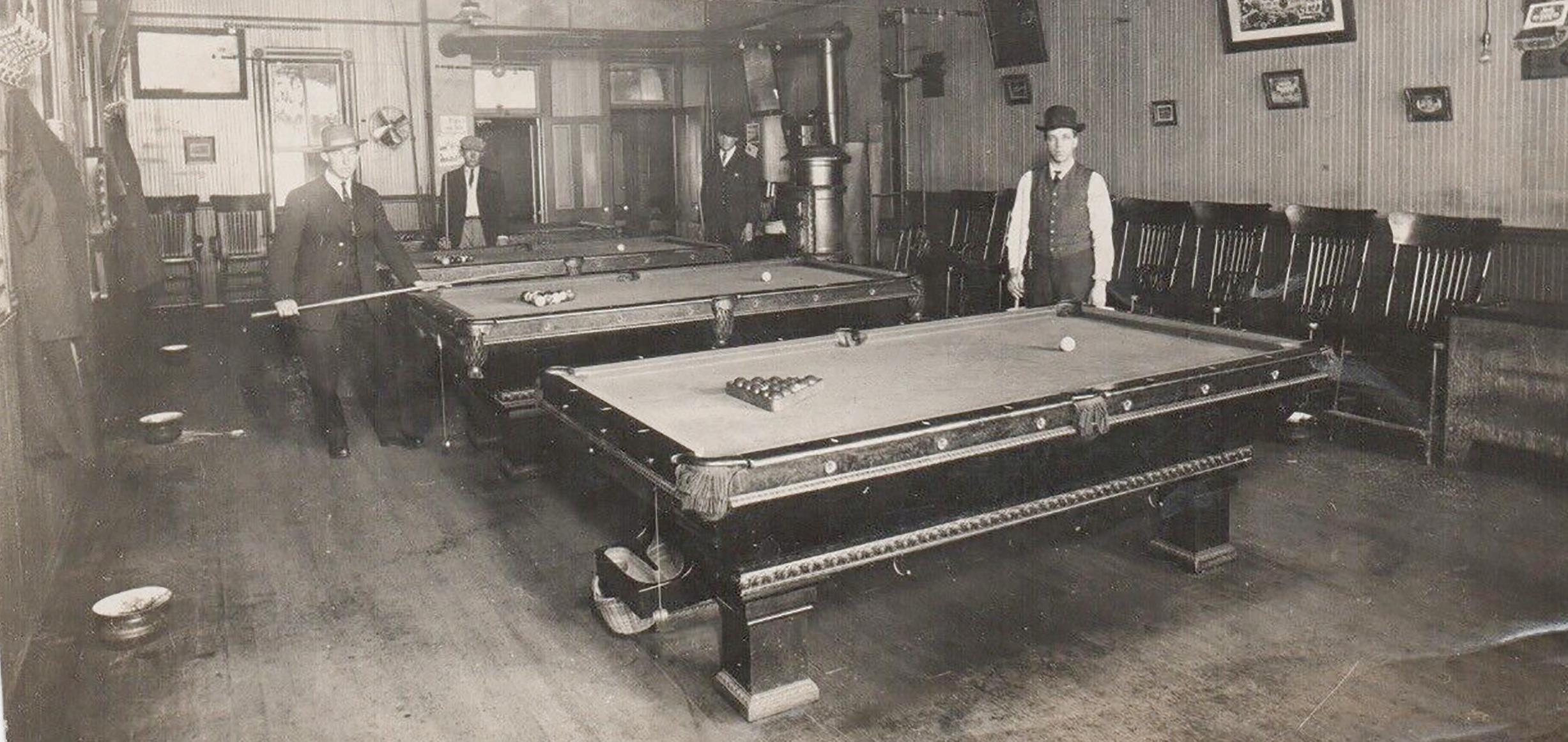
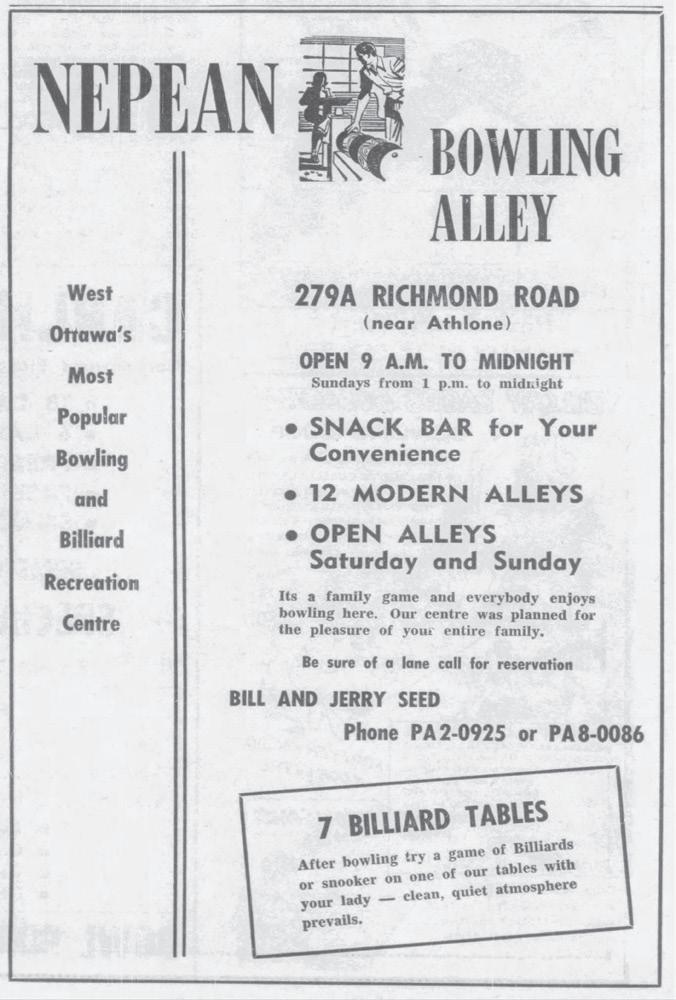
Looking to play pool or snooker? You likely have to go outside of Kitchissippi to do it. Rising commercial real estate costs have sadly made pool tables a rare sight within the ward’s borders, with just a single lonely table at the Carleton Tavern and a pair of tables at the Westboro Legion.

A century ago, neighbourhood residents faced the same problem, but for very different reasons. In the late 1800s and early 1900s, pool halls were considered one of society’s greatest evils. The battle to open a pool room in Hintonburg was a long and fierce one, which pitted blue collar workers and teens with limited recreational options against local politicians, churches and community groups for many years. Pool halls were long seen as a venue for lower class men to congregate, where gambling, drinking and swearing was commonplace. For taverns, licensing of pool halls fell to each municipality, many of which were happy to exercise their right to refuse. The oversight of billiards in Ottawa
goes all the way back to 1850 when Bytown Town Council passed Bylaw Number 12, introducing the licensing of “billiard tables, ball alleys, skittle alleys, nine or ten pin alleys and also pigeon holes and bagatelle.”
An annual fee of seven pounds, ten shillings was due for every hall or house where these games were played. Failure to pay the fee was a five pound penalty “or be imprisoned within the County Jail for a period not exceeding one month.”
In the 1850s, Murray’s Billiard Room at the corner of Sparks and Metcalfe became a popular place to play, and even featured a saloon at the rear, known as “The Office,” with “the best of liquors and cigars always to be had at the bar.”
Paul Pelletier was an experienced pool hall proprietor from Quebec when he opened Hintonburg Village’s first pool room in March 1905 in the new ”Jones Block” building, in the fancy new digs of what is now Hello Dolly at 992 Wellington at the corner of Irving.
In April 1905, Ontario Premier Whitney targeted pool rooms, particularly problematic ones in Toronto. The attorney-
general himself oversaw the shutdown of the Toronto Junction pool room, after detectives had been tapping wires to the betting room for three weeks. Many accused the government of being hypocritical, wondering how gambling could be allowed and even encouraged (including by women and children) at Woodbine racetrack, yet were so swift to shutter pool rooms.
In February 1907, brothers William and J.B. Duford applied for a license to open a second pool room in Hintonburg. The Village council was to consider it, but local citizens had clearly seen enough. At the next council meeting, local clergymen presented a petition against the pool room signed by 150 ratepayers, as well as an impassioned letter from Rev. Father Fitzgerald of St. Mary’s in Bayswater. The group not only opposed the new application but went a step further, asking Council to close Pelletier’s room.
“The pool room is an evil resort and should be put out of the village,” they claimed.
Councillor Bulllman supported them and put forth a proposal mirroring Quebec, raising licensing fees for each pool table. With the passing of Hintonburg By-Law 232, the license fee went from $5 to $100 per table.
The new fee killed the Duford plan, and when Pelletier’s renewal came up that spring, he closed shop. By June Pelletier was operating on York Street. His departure was gleefully reported by the Citizen: “The village has not suffered a heavy loss by the removal of the pool room. It is stated that it had become a rendezvous for boys and young men who might have been otherwise better employed.”
However, just months later, in fall 1907, Hintonburg became part of the city of Ottawa. The village now fell under city bylaws. No longer could the local clergy direct neighbourhood affairs so directly.
William Duford reapplied for a pool hall license. Competing petitions were submitted to Ottawa Board of Control. One had 288 ratepayer signatures supporting a pool hall, the other, 256 against. Rev. Father Fitzgerald wrote again, stating that many parents felt Pelletier’s room had been a “source of detriment to the morals of the young men.”
Though Mayor Scott and Controller Hopewell were “on principle opposed to public pool rooms,” other controllers suggested that it was unfair to block pool halls in one area of the city but not others.
The Mayor was skeptical. “I have nothing against pool if it is played under proper conditions. I have nothing against the

1: A photo of an old pool room, much like how the ones in Kitchissippi used to look.
2: An Ottawa Citizen clipping from Sept 6, 1961 promoting the Nepean bowling alley, which also housed pool tables.
3: The Broken Cue pool hall in Wellington Village was located in the former Herb and Spice building. It’s seen here in a March 1978 photograph.
CREDIT: CA-24328.
drinking of whiskey in the home, but if I could I would close up every saloon in the province.”
In the end, the license was granted and, ironically, the 24-year old Duford opened in Pelletier’s old spot at 992 Wellington. A year later he moved across the street to 987½ Wellington — the spot where Maker House exists today.
To counter Duford’s pool room, St. Andrew’s Church of Ottawa formed a new club, the “Hintonburg Social Institute.” Securing space on the second floor of the Fairmont Avenue fire hall, young men were invited to meet nightly “to play cards, read the current magazines kindly placed at their disposal by the St. Andrew’s Church Men’s association, or to converse in their well appointed room.”
The Institute held a formal opening on May 2, 1908, where Mayor Scott spoke, and promoted “that great benefit would be derived by all the young men of Hintonburg who made use of the comfortable rooms.” Later that month, Michael H. Fagan was elected president of the Institute, as the group began to organize baseball and football teams to compete in city leagues. It was abandoned two years later.
Duford’s pool room closed by mid-1911, but the same battle waged in other neighbourhoods. Glebe and Old Ottawa South residents banded together in 1912 to successfully fight a proposed pool room on Bank Street, in the highest-attended meeting ever held in the vicinity.

Following WWI, with prohibition in place in Ontario, there was reduced concern about pool halls (though churches were still hotly opposed). Between 1920-1921, two poolrooms opened across the street from each other: Alex Ristow at 1101 Wellington, and Emmett Brady and Arthur Richer’s room at 1100 Wellington.
Most memorable to long-time residents are the pool hall and bowling alley on the second floor of what is now Giant Tiger, then known as the United 5¢ to $1 store. Ristow opened the Recreation Billiard Academy there in 1932. It soon became the Fisher Athletic Club, then Fisher Billiards until it closed around 1967.
The Fisher pool room wasn’t squeaky clean, however. It suffered occasional raids, including in 1953 when police arrested 17 customers and seized over $1,000 in cash and three truckloads of gambling furniture.
On the other side of Kitchissippi, Omer Major opened the Westboro Bowling Academy in 1931 in Benjamin Bodnoff’s building. After WWII, Bill Seed’s Nepean Recreation Centre — later Nepean Bowling — opened at 279A Richmond Road
Today, the Orange Monkey at nearby City Centre (opened in early 1989 by three Carleton University students, and named for one of their nicknames) remains a bit of a throwback to the early days of pool rooms. Just too bad we have to leave Kitchissippi to get to one.

















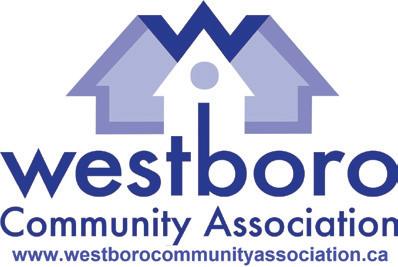

















OUVERT TOUS LES JOURS MAI OCTOBRE à OPEN DAILY MAY OCTOBER to
OUVERT TOUS LES JOURS MAI OCTOBRE à OPEN DAILY MAY OCTOBER to
For hours, vendors, and events: Pour nos heures d’ouverture, vendeurs et événements : FOLLOW
For hours, vendors, and events: Pour nos heures d’ouverture, vendeurs et événements :
PARKDALEPUBLICMARKET.CA
PARKDALEPUBLICMARKET.CA
@PARKDALEPUBLICMARKET



CENTENNIAL SEASON
OPENING CEREMONIES & MARKET KICK-OFF
May 11th, 2024
9:00 am - 5:00 pm
OTTAWA FLOWER MARKET COLLECTIVE
*reoccuring event*
May 11th, 2024
9:00 am - 1:00 pm
* June 15, July 20, August 17, September 21, October 12
MOTHER’S DAY FLOWER MARKET
May 12th, 2024
9:00 am - 5:00 pm


CSA PICKUP DAY & STAGE SERIES
Every Thursday
May 16th, 2024 - October 31st, 2024 1:00 pm - 6:00 pm
VEGANS WHO SNACK FOOD & ART FESTIVAL
May 31st, 2024
September 6th, 2024 5:00 pm - 9:00 pm
100TH BIRTHDAY PARTY NIGHT MARKET
July 10th, 2024 5:00 pm - 9:00 pm
PRIDE NIGHT MARKET
August 17th, 2024 5:00 pm - 9:00 pm
OUR 100TH HARVEST NIGHT MARKET
October 9th, 2024 5:00 pm - 9:00 pm
HOLIDAY MARKET
November 23rd, 2024
12:00 pm - 6:00 pm
The annual holiday tree and decor sale will run from Nov. 23rd - Dec. 24th
* LOOK ON NEXT PAGE FOR NIGHT MARKET DATES *
Apples
Blueberries
Cherries
Peaches
Pears
Raspberries
Rhubarb
Strawberries
Watermelon
THE #1 SUPPORTERS OF PARKDALE PUBLIC MARKET
Every month of the harvest season, we will share what we learned from a producer vending at the Parkdale Market. This month’s featured business is none other than Robinson Greenhouses!
For over 60 years the Robinson family has been supplying the Market with fresh fruits, vegetables, plants, and flowers! The Robinson family grows veggies in their Hawkesbury greenhouses as well as sourcing the best produce from Ontario and Québec, from Montréal to Niagara Falls! A familyrun business for four generations, Robinson Greenhouses is open daily from May through October, from 8 a.m. to 5 p.m., at the Parkdale Public Market.
Asparagus
Beans (Green/Yellow)
Broccoli
Cabbage
Carrots
Cauliflower
Corn
Cucumber (Field)
Eggplant
Garlic
Kale
Lettuce
Mushrooms
Onions
Peas (Snow)
Peppers
Potatoes
Pumpkin
Radishes
Spinach
Summer Squash
Sweet Potatoes
Tomatoes (Greenhouse)
Zucchini



MAY/MAI 3
MAY/MAI 3
JUNE/JUIN 5, 12, 19, 26
JUNE/JUIN 7, 14, 21, 28

AUGUST/AOÛT 2, 9, 16, 23, 30
AUGUST/AOÛT 2, 9, 16, 23, 30
JULY/JUILLET 3, 10, 17, 24, 31
JUNE/JUIN 7, 14, 21, 28
JULY/JUILLET 5, 12, 19, 26



SEPTEMBER/SEPTEMBRE 6
JULY/JUILLET 5, 12, 19, 26
NOVEMBER/NOVEMBRE 1
SEPTEMBER/SEPTEMBRE 6
SEPTEMBER /SEPTEMBRE 4, 11, 18, 25



N O VEMBER/N O VEMBRE 1
OCTOBER/OCTOBRE 4
OCTOBER/OCTOBRE 4

DECEMBER/DÉCEMBRE 6









A UGUS T/ A OÛT 2, 9 , 16, 23, 30




SEPTEMBER/SEPTEMBRE 6



OC T OBER / OC T OBRE 4









AUGUST 7, 14, 21, 28
DECEMBER/DÉCEMBRE 6

NOVEMBER/NOVEMBRE 1
OCTOBER/ OCTOBRE 2, 9











PARKDALEPUBLICMARKET.CA W




DECEMBER/DÉCEMBRE 6
















PARKDALEPUBLICMARKET.CA W






Westboro resident Shilhav Mayo has been managing bookstores for the better part of a decade and always dreamed of opening her own store. In October 2023 that vision became a reality.
She’s the owner of Westboro Books, located at 314 Richmond Rd., a new community hub for lovers of reading and literature. Its storefront next to the Village Quire is recognizable by the logo of a monkey keying away on a typewriter.
“I have a history with books,” said Mayo. “I have managed bookstores for almost a decade, and to be honest, I always had this dream of owning my own bookstore, and if I didn’t do it now, I probably never will. I really want people to feel like it is a place they can gather—kind of a library but with books for sale.”
When it comes to buying books, Mayo said it’s easy to default to a traditional, major retailer. While perhaps convenient, shopping at Westboro Books comes with a neighborhood experience. Even so, it’s not always easy to compete.
“The competition is big. You definitely have to find your own niche,” said Mayo. “I had this vision of what I wanted to have in a bookstore of my own which is centered around a community, a place where people can gather and enjoy everything books and literature, that kind of calm, fun environment.”
Mayo’s approach to her store creates less of a shop and more of a stop. Yellow and blue benches sit on every bookshelf, letting people peruse instead of purchasing.
But her community focus goes beyond a hub.
Westboro Books hosts numerous events, including book clubs, writers' workshops, and Local Author Sundays, with even more underway.
“I have a lot more future events in


Westboro Books was founded by Shilhav Mayo, who always dreamed of running her own store.
motion,” said Mayo. “One of the workshops I am hoping to host here is a Manual to Life. A series of speakers from different realms of expertise—lawyers, accountants, and dietitians—speak about different topics with the public.”
“We might have a workshop with a bibliotherapist,” she added. “We’ll have our live-drawing classes, and I want to do some one-off events like trivia nights and writeoffs, a session where, based on prompts, people write something and others get to vote on a winner, maybe get a prize.”
Other events include play readings for kids, adults, and both. One function previously held at Westboro Books was a series of two workshops around Indigenous art and poetry hosted by Pamela Naymark.
“She’s been so welcoming in terms of anything that people want to do culturally in her space,” said Naymark. “It's a very clean, very modern feeling. Whether you are visiting with your kids, friends, or family, there is something for everyone, which is what she [Mayo] worked so hard to cultivate in her store.”
It appears readers are putting their ebooks and Kindles away, opting for a physical product instead. Stats from the Canadian book market show printed book sales have climbed since 2019, perhaps in part due to the pandemic.
According to the stats, 77 percent of all book purchases in 2023 were hard or soft-cover purchases. In the first six months of 2023, digital books comprised a smaller
percentage of purchases compared to the same period in 2022—a 23 percent decrease.
“There’s a move towards the analog. People are buying records, people are buying cassettes, and I think people really like the physicality of books,” said Mayo. “I think people also enjoy going to physical stores after COVID. Maybe people are nostalgic for something simpler. As things are becoming more and more digital, people are still moving back.”
For Mayo, the experience of a physical book is also a sensual one.
“It is different holding a book physically and smelling the pages. There are these sensory feelings that you only get from reading on pages,” she said.



























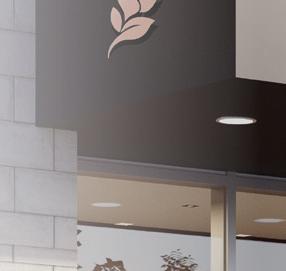





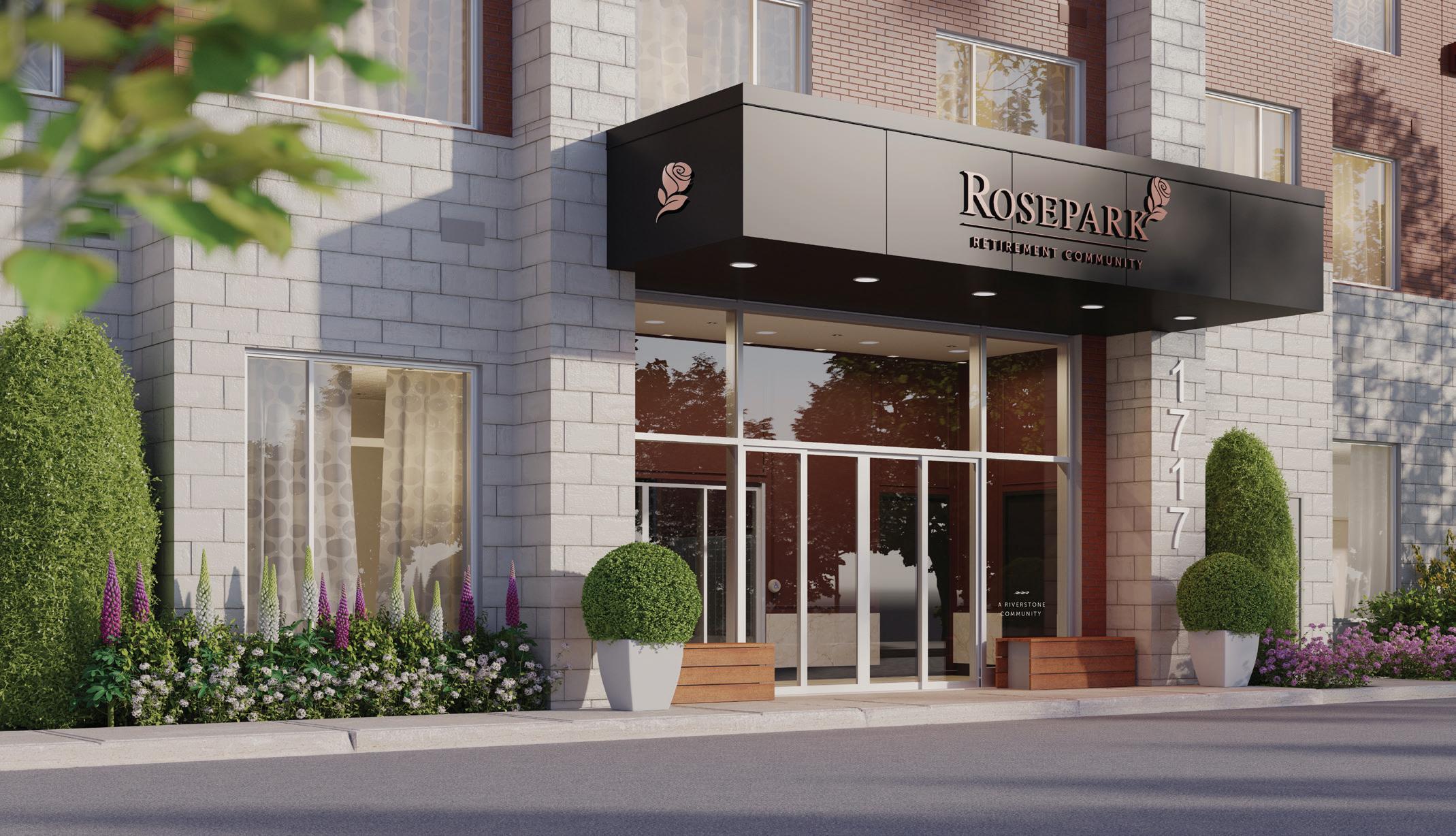





Before you tackle that tough deck-staining project, get everthing you need at Randall’s to do the job right.
Receiving the best advice and following it will yield the best results. “Proper wood surface preparation and a high quality coating are super important to the outcome of your project and the longevity of your wood surfaces,” says Randall’s owner, Marc Pilon. “The preparation for an exterior job is quite intensive and you’re investing in a high quality coating.” Performance of the coating will greatly depend on preparation, application, the location and use of the space.
EASY maintenance is a priority, too.
The Randall’s team really knows stains and wants you to succeed. “The end result will be in clear view for all your friends and neighbours to see so you want to execute your project to the best of your ability and not have to redo anything. Ask us,” says Pilon. “Randall’s will take the time to make sure that you have all the information that you need.”
1. Clean the deck with Allpro concentrated deck wash and rinse thoroughly to get all dirt off and to kill all the organics. (Organics show up as black discolouration spots when stain is applied.)
2. Sand thoroughly with 60 to 80 grit sandpaper. Stain within 24 hours so the wood pores do not close.
3. Always use a thick bristle brush to apply stain. A brush gets the stain down into the wood fibres. The goal is to apply as much stain as the wood will accept and brush off any excess. Some stains may require two coats, so labour time and weather need to be considered before starting.
4. Stain the skirting first. This will prevent the runs and drips from the deck surface from showing as dark streaks.
5. Apply stain on a dry overcast day, ideally, with the temperature between 10-25C. (Always follow the manufacturer’s application instructions!)
6. Having 24 hours of dry weather post staining is a must - or have a large tarp available if rain threatens.






Environmentally-friendly products?
Yes. Randall’s has them. Canadian-owned stain companies such as C2 and Sansin offer water clean up products that are very environmentally friendly (yet stand up to our harsh Canadian climate).
Got a tough project? Ask the staff at Randall’s. They will custom match stains and can also refer customers to trusted contractors who specialize in exterior wood restoration.

Randall’s is located at 555 Bank St. at the Queensway (FREE parking off Isabella St.). Visit Randalls.ca or give them a call: 613.233.8441.
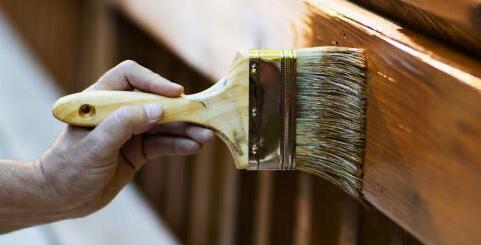

























Kitchens and bathrooms are always popular areas of the home to renovate. However, homeowners don’t have to break the bank on a full-blown gut and re-do.
To Do Done Renovations frequently do “kitchen and bathroom refreshes that take a few design elements and incorporate them into the existing structure,” says company founder and owner Tonya Bruin.
Bringing a new look to your kitchen can be as simple as adding a new backsplash. It can make a huge difference on the aesthetics. In the bathroom, a new vanity, fresh paint, and maybe a refresh of the flooring might be all you need to do to make things better.
Also, “updating lighting in any room often helps to modernize it,” adds Bruin, who for the past decade has been helping homeowners stay on budget while making better use of and increasing enjoyment of their interior or exterior spaces.
“I started this company as a response to the dismal customer service that I faced in the construction industry,” says Bruin, who opened the business in 2015. “I knew that I could help out this industry by applying my skills with people, with finances, and with project management.”
One of the more recent customer-focused renovations Bruin has done involved their offices near downtown Ottawa. “Our office has been located on Bronson Avenue for the past eight years, however, it was really broken up into smaller offices and we didn’t have a very good meeting space for either our team or for our clients.”
So, being a renovations company, Bruin decided to renovate!
“We ripped out a couple of walls to open up the space so that we can have more


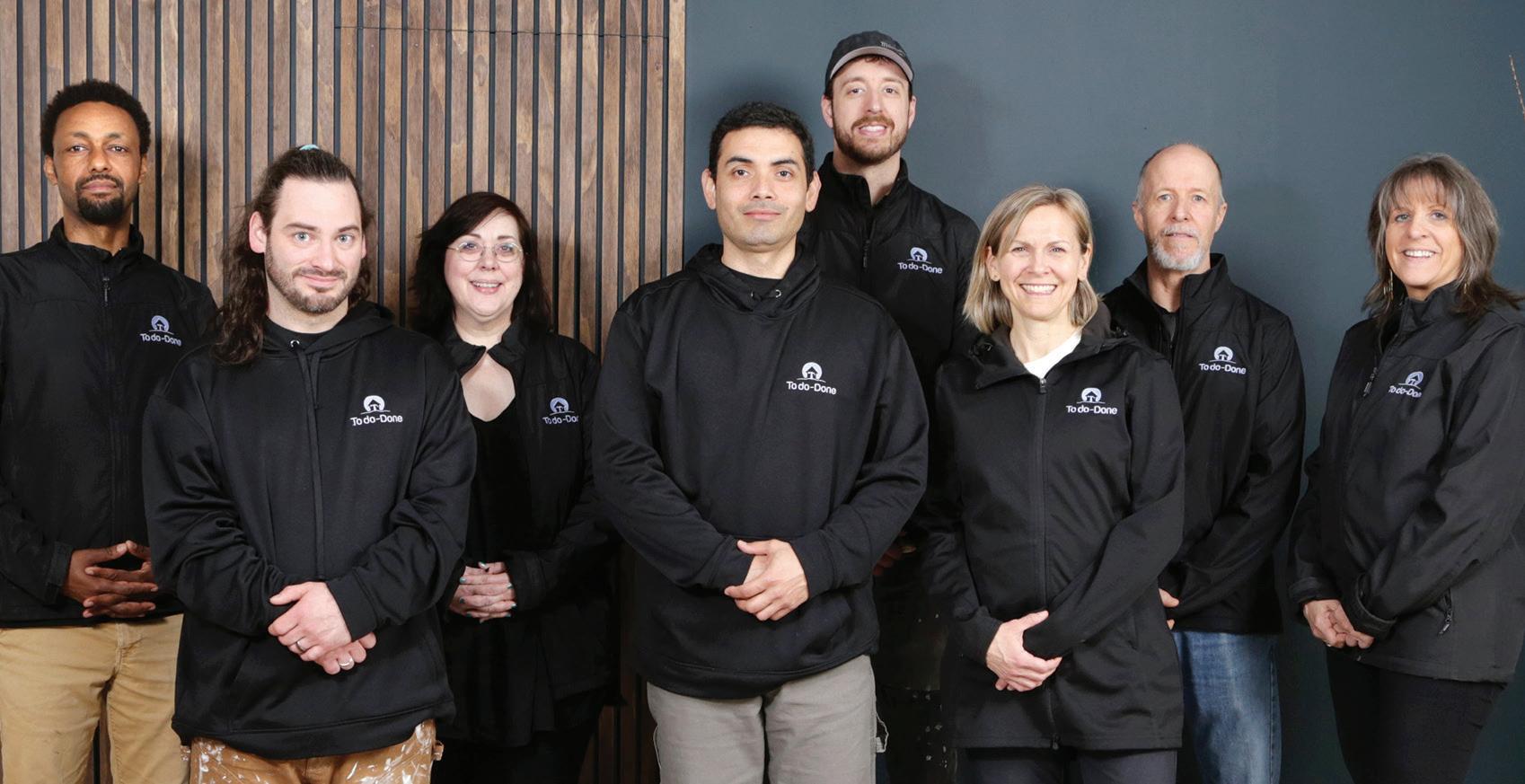
comfortable meetings as a team,” says Bruin. “This same space also allows us to meet with clients and take a look at designs and inspirations up on our big screen together. We can also get together with our clients to review their estimate and pricing and budget together.”
Visit the NEW To Do Done Renovations design centre at 373 Bronson Ave. (just north of Gladstone Ave.). They serve both Ontario and Quebec residents within a 30km radius from downtown Ottawa. To get the ball rolling on your next renovation, e-mail info@2dodone.com or call 1-800-2Do-Done (1-800-236-3663). Easier yet, simply fill out the ‘request an estimate’ form here: https://www.2dodone.com/contact/








Our outdoor space has become more important than ever, particularly since the pandemic. We’re cocooning, we’re staycationing, we’re interested in making indoor/outdoor connections and extending our living space to the outside.
With that in mind, All Things Home put together a panel for the recent Ottawa Home & Garden Show to explore the importance
of our outdoor space and how to make the most of it. The panel featured Welwyn Wong of Welwyn Wong Landscape Design, Michael Willis of Roger Willis Pools & Landscapes and Lana Doss from Ritchie Feed & Seed.
Here’s an edited excerpt of the talk.
ATH: How much should you spend on your outdoor space?
Welwyn: A study by Laval University in 1999 looked at homes that had gotten their front yard professionally landscaped versus the same home, in the same neighbourhood, that didn’t. Those that did could fetch 15 to 25 per cent more and they sold faster. That’s been our go-to for clients: unless they really want to spend more, I advise them to try to stick within 15 to 25 per cent of the value of their home.
ATH: What projects give you a good return on investment or hold their value?
Mike: Curb appeal’s important, so landscaping the front holds its value. Pools — for the right buyer — hold their value, too. And having nice indoor-outdoor living features, fire features, things that are nice for entertaining are also a good idea.
Lana: And trees as well. Trees year over year continually add to the value of your home. Just get some guidance on size and how close to put them around your house.
ATH: Pools became a hot ticket when the pandemic hit. Are they still in big demand?
Mike: For sure. We naturally gravitate to water. And there’s so much you can do with a pool and have a staycation in your backyard. Being able to maximize your space and having multifunctional spaces is also becoming big.
Welwyn: Using natural and classic materials is another. And that relates to what we’re doing with interiors; we tend to then translate that to the exterior.
Mike: Smaller pools are trendy,
simply because many don’t have a big backyard. So, a lot of pools are smaller, with a constant depth and more features incorporated like bench seating and sunken loungers. Plunge pools are also popular; as are fire features. Nothing is nicer at night than having a fire feature illuminate the landscape.
ATH: Not everyone has a big budget, but they want to create impact. What would you suggest? Welwyn: We all have side yards and the distance between neighbours can be tight. What I sometimes suggest is to get together with your neighbour and do a garden together. You’ll have more room together to do a wider path than you would on your own and it allows you to have plantings on both sides. In this way you can both share the cost and both get to enjoy the effect.
Mike: One easy thing to do is to define your garden edges by using an edging stone, which brings an interesting element to your space but also makes it easy for maintenance — it’s much easier to weed up against a garden barrier or to trim grass. Lighting is a huge feature. We use our outdoor space often in the evening, so doing simple landscape lighting is definitely a good idea.
Lana: Start by creating a small sitting area where you can enjoy your morning coffee. One that’s easy to do on your own is a small flagstone patio with a bench,
maybe a little water feature, an ornamental tree.
ATH: One final question — why are our outdoor spaces important?
Lana: We are a part of nature but we’ve tried to remove ourselves from nature, so anytime we’re back in it is good. Spending time outside grounds us, it makes us feel a little more “right” and allows us to get that distance from our technology and our chores and just enjoy it.
Welwyn: There are some things in our home that we have to do, like the roof, but what we do outside in our landscapes is like vitamins to us; we don’t necessarily have to have vitamins, but they’re certainly good for our mental health.
Mike: You have to look at your landscape — whether it’s a patio, terrace, fire feature, pool — it’s an extension of your home, it’s really like another room. It’s having that indoor/outdoor approach and that’s so important.

AnitaMurrayistheco-founderof AllThingsHomeInc.andownerofThreeC Communications.Theveteranjournalisthas coveredtheOttawahousingindustrysince2011.














Luciano Sicoli respects, values and appreciates his customers. He takes the time to educate the customer about different materials, different options that are available to the customer and the process that will be used to complete the work. You meet the boss, the boss is the one that comes to discuss your issues and the boss will be the one that comes to do the work. We do not sub-contract out our work to anyone. Our reputation is too important. I have heard customers say that people have come, given them a price and just left them with their business card and many times have other people come to do the work.
Luciano’s teacher, Antonio Sicoli, his 82-year-old father, who still comes with him to different job sites, has provided him with a simple formula for longevity: be honest with your customers, make sure you provide them with an excellent job and make sure that your prices are fair and you will have many telephone calls, along with many satisfied customers.
My father always taught me that even






though you may be comfortable with the skills you have acquired, there is always more to learn and you can never stop this process if you choose to strive to be the best you can be.
Learning this craft is not only about acquiring skills, it is about investing passion into your work. This allows Luciano Sicoli to provide a little bit extra in a job. Others may not always do this part. An example of this is when bricks get installed on the front of a home, on a chimney or elsewhere, there may be mortar on the face of those bricks. We mix a special muriatic acid solution and wash the bricks upon completion of a job to clean them. You would not believe the number of customers that I visit that ask me what can be done to remove the mortar from their bricks. This issue is quite often on new home construction, where the bricks have not been cleaned after the bricklayer has intstalled them. Investing two more hours to clean the front face of bricks on a home, where customers are investing $400-


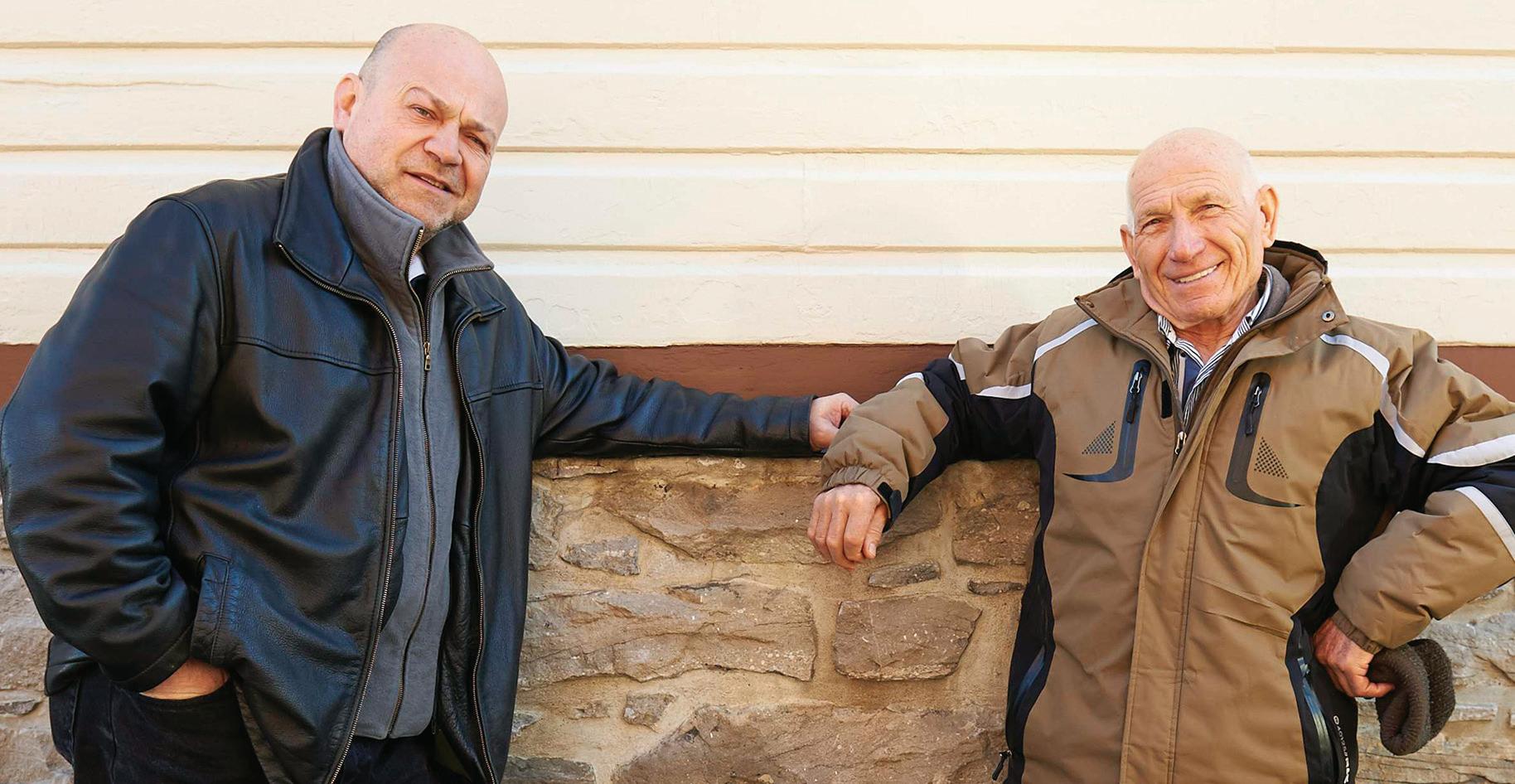
$500,000 should not even be something to have a discussion about. It should be a given.
We take pride in our work and when we drive by a job that has been completed by L. A. Sicoli Masonry and Restoration it provides a sense of gratification that can’t be described by words. Word of
mouth from our customers is always the best form of advertising and this is greatly appreciated.



















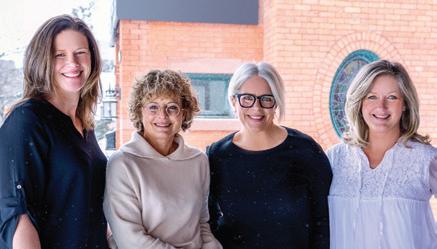




















It’s no secret that pollinators are being hammered by the onslaught of climate change, habitat loss and disease. Without pollinators, crops are in serious trouble and so are we. Besides, the buzz of bees and the whirr of hummingbirds hard at work is one of the great pleasures of a summer afternoon. Nectar-rich plants like coneflowers, marigolds, cosmos, columbine and lavender provide food for pollinators and add a splash of colour to your garden, balcony or deck.

Ottawa typically endures a dry spell each summer. Yarrow, hostas, ornamental grasses and sedum (often used for green roofs) are growing in popularity because they require minimal water and maintenance and add elegance and colour to your property.

While our gardens will never parade down a fashion show runway, like clothing, they do have trends. Here are seven for this year’s growing season.
“I’m seeing a lot more vibrance in plants without flowers,” says Lana Doss, a gardening expert and member of Ritchie Feed & Seed’s
Green Team. Instead of just traditional bright floral displays, homeowners are gravitating toward darker red and even purple-leaved plants as well as contrasting lime green, yellow or variegated foliage, often with textured leaves. These plants, which do typically flower briefly or subtly, fare well in shady areas that many brightly flowering plants don’t like, and, when the colours are mixed, they create dramatic contrasts. Perennials like hostas and coral bells are available in an array of colours.
colour palette, ornamental grasses and lots of uncluttered space typically characterize minimalist gardens. If you have room, anchor the space with a single tree, one that’s not too tall and has subtle colour or texture.
As backyards have gotten smaller, so have their trees, according to Doss. She’s seen an increased demand for “urban” trees that grow no higher than 20 feet, yet offer shade and cool an outdoor space by releasing water vapour that brings down the temperature. Trees also sequester carbon dioxide, a greenhouse gas. Look for trees like hornbeam, serviceberry and pagoda dogwood, but check with a nursery or a site like ecology.ca for recommendations on planting conditions.
Intense summer rainfalls seem on the upswing, bringing soil erosion, flooding and pollution of waterways as rain courses over roofs, pavement and other contaminated surfaces. Rain gardens — using plants that don’t mind a good soaking such as native grasses, black-eyed Susans and some shrubs — absorb the excess water, including pollutants. “It could be as simple as redirecting a downspout into a garden with river rocks and plants that can stay wet,” says Doss. Check the City of Ottawa’s detailed information on rainwater projects, including rain gardens, by searching online for “Rain Ready Ottawa.”
Too busy to spend all your spare time gardening? Go for minimalism, which demands less maintenance, gives your backyard a refined, contemporary look and creates a calming ambience — exactly what’s needed after a hectic day. A simple
Doss says climate change is really hitting home and that’s showing up in gardening trends. “It all has an ecological component. I’ve seen more interest in using environmental methods in the past three years than in the last three decades.” That includes younger homeowners growing their own, nutritious organic food, a skill new to many of them because their parents didn’t garden. Growing herbs, vegetables and fruit is astoundingly easy once you get the hang of it, and the maintenance (weeding, for example) is a relaxing if endless task. Check with your garden centre about soil, light and other conditions when choosing seeds and plants.

PatrickLangstonistheco-founderofAllThings HomeInc.,wheredetailsonhowtodomostof theabovetaskscanbefound(allthingshome.ca). TheveteranjournalisthascoveredtheOttawa housingindustrysince2008.
Finding the right time to buy or sell. It’s always one of the top questions realtors hear. If you’ve been asking that question to yourself, don’t worry. It’s not too late. But don’t wait much longer.
“April, May and June tend to be the busiest months for the real estate market,” says Jen Stewart. “The spring market is a time when families want to buy,” in order to get settled before school starts in the fall.
Many people prefer to buy, sell and move during the good weather months, so springtime brings a confluence of buyers and sellers to the market.
“Spring is also when many relocation buyers may be shopping,” adds Stewart. That part of the market includes various government departments and agencies.
The best part? Interest rates appear to have peaked and are poised to start dropping this summer. Many buyers, including an influx of first-time buyers, are ready to buy.
“It’s taken a bit of time to get to this point and have buyer confidence renewed,” says Jen, who is back in Ottawa after a oncein-a-lifetime dogsledding trip in northern Scandinavia, to raise money for the Ottawa Youth Services Bureau “More serious people are out shopping for houses and inventory is still low — especially in the more walkable areas like Kitchissippi.”
Buyers are ready to enter the market, which means it’s a good time to purchase properties.
“If you’ve got a really lovely yard or a swimming pool, it’s always better to showcase these things when they look the best,” adds Jen, who has just recently planted herbs in her garden. It’s May, so the time is now.
Potential buyers like to imagine what their life will be like when they live in the house, so a nice deck or space to entertain outside is certainly a lot easier to imagine when it actually looks good in real life!
The bottom line is that there are no hard and fast rules. Every situation is different and it’s important to have realistic expectations and a professional realtor like Jen Stewart on your side.
Jen Stewart has over two decades of experience helping Westboro area buyers and sellers get results.
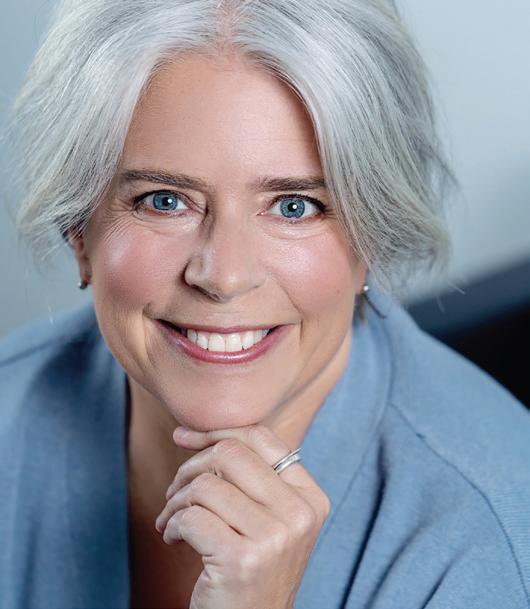
Contact her at 613.795.9793 or email home@dianeandjen.com to ask questions and/or get your home listed. Don’t hesitate to ask Jen about her recent dog-sledding trip to Sweden. www.dianeandjen.com





Jeff McIntyre creates graphic novels that are accessible for allSTORY AND PHOTO BY MAT DICSI
In the back of a Westboro driveway sits a 1985 Buick LeSabre dusted from long trips across Canada. Perched inside the neighboring garage is Jeff McIntyre, a graphic novelist and illustrator, who has been penning his latest project.
McIntyre’s studio is where he spends most of his days. Surrounded by a variety of different art pieces and tools, he works to sculpt each page of his cartoon books with the love and care needed from an artist.
That’s what got McIntyre’s creative juices flowing. But his career didn’t start with graphic novels; instead he commissioned art.
“In my adult life, I was a muralist, an oil painter largely, as well as a sculpture and installation artist. But about six years ago I put down my paintbrushes and started to do comics and graphic novels. It was inspired in part by my kids. They were getting into comics, so I just started writing and drawing and never stopped.”
“People that are from the region might only be a small group of the readers of the book, but I do believe it is extra special when somebody from the region of that scene can pick it out and they can feel at home with the picture,” said McIntyre. “I love to illustrate the scene of a place. I’ll actually send people from that area the drawings. If I draw a motel, I’ll send the motel owners the drawings. I drew somebody's homestead in Port au


Persil in chapter two and I got to meet the original family that has been there for hundreds of years.”
McIntyre has also been generous with giving away his books. When he finished his first novel, the cartoonist sent it to childhood hero Mosher at the Montreal Gazette.
“All these years later he fell in love with the work,” said McIntyre. “He’s been helping me for a couple years, cheering me on to get these out there.”
When designing his books, McIntyre goes with larger pages, fonts, and comic boxes, to make it more accessible to those who find it difficult to see.




“I always dreamed about being a newspaper cartoonist, an editorial cartoonist and political cartoonist,” McIntyre told KT. “At a very young age I started to draw Terry Mosher's cartoons. I wanted to be just like him. I read them every week since I was a small child. I would copy his style and try to draw Mulrooney the way he did, or Chretien, or all the characters in political history and politics you would draw.”

Four years later, the Kitchissippi ward resident completed his first graphic novel which is a seven-chapter, 250-page novel. Throughout the process, though, he also wrote Salmon Run, his latest novel.
McIntyre’s love for his art shows in the care he takes for each individual image. Ensuring authenticity, he takes road trips in his Buick LeSabre. For every 11 months spent perfecting the pages, McIntyre spends one month on the road.

McIntyre’s love for his art shows in the care he takes for each individual image”
His newest graphic novel Salmon Run surrounds topics of mental health and addiction. It can be purchased at local bookstores including Perfect Books, Spaniel’s Tale and Westboro Books, and can be found online at Blueberry Lake Publishing.
“As a happy dad, husband, and neighbour in a wonderful community, I am grateful to be able to share in this story, and maybe it will provide a little bit of hope to other folks out there,” said McIntyre.
















• July 24, 2016: Abdirahman Abdi, a 37-year-old SomaliCanadian, was beaten outside of his home on Hilda Street in Wellington West by constables Dave Weir and Daniel Montsion.


• July 25, 2016: Abdi was declared dead the following day. According to the attending doctor, Abdi had passed away 45 minutes before arriving at the hospital.
with a weapon. Officer Dave Weir was not charged and treated as a witness.
• July 17, 2018: The family of Abdirahman Abdi sued the Ottawa Police Services Board, then police Chief Charles Bordeleau, and constables Daniel Montsion and David Weir for more than $1.5 million.
• October 20, 2020: Ottawa police Const. Daniel Montsion was found not guilty of manslaughter, aggravated assault and assault with a weapon in connection with the 2016 death of Abdirahman Abdi.

• July 2016: The Justice for Abdirahman Coalition was formed just days after his death.
• March 6, 2017: The Special Investigations Unit concluded that Constable Montsion should be charged with manslaughter, aggravated assault, and assault
An inquest into the death of Abdirahman Abdi has been announced almost seven years after the 36-year-old’s brutal death outside his Wellington West apartment.
The Somali-Canadian died after an altercation with Ottawa Police on July 24, 2016. The inquest will be conducted by the coroner, before a jury of community members, to provide the public with information around the circumstances of death, according to the City of Ottawa website. The jury’s conclusion is not binding, but provides hope that, if implemented, it will prevent future deaths.
At the time, Abdi had been struggling with his mental health when he was chased from the Hintonburg Bridgehead Coffee Shop, where he was accused of groping a female customer. He fled to the front steps of his apartment building at 55 Hilda St., where he was left unconscious. He was pronounced dead the next day.
• January 25, 2021: A settlement was agreed upon between the family of Abdirahman Abdi and OPS. OPS presented a report on how it would work with the public to develop that strategy, including consulting with Black, Indigenous, LGBTQ+, and mental health advocacy groups.
The Coalition has been focusing their efforts on uplifting the community. The Justice For Abdirahman Bursery is awarded during the fall and winter semesters for Black postsecondary students in Ontario who are active in the community and are passionate about social justice and social advocacy.
With the news of the inquest announced, the Coalition is hoping for closure.
“We will be watching from the sidelines and making sure that we get answers and closure. And that the investigation is a fair one and one without bias,” said Ifrah Yusuf, chair of the Justice for Abdirahman Coalition.
Yusuf wants to see the government and police take care of the city’s most vulnerable
and ensure that qualified professionals engage with those who suffer from mental health episodes.
“With the pandemic and cost of living crisis, mental health needs are at an all time high,” she said.
In 2020, Ottawa Public Health published the Mental Health of Ottawa’s Black Community study, designed to address gaps in understanding barriers to access.
“To date, OPH has been working with Ottawa’s Black community to disseminate findings of the research study and implement programs, services and strategies aimed at improving service quality,” wrote Hodan Aden, supervisor for Wellness and Harm Reduction at OPH. “This work includes efforts to reduce and challenge racism through the development of anti-racism and anti-oppression workplace policies.”
The report found spirituality to be one of the most important strategies to maintain good mental health. Faith leaders were one of the first contacts for many people in the African, Caribbean, and Black (ABC) communities.
In collaboration with the Somerset West Community Health Centre, OPH developed a centralized list of ACB centered mental health services “to increase awareness and access of culturally appropriate services,” the report read.
Community members have a variety of resources ranging from crisis support lines, individual counseling, to group support.
“The resources offered by organizations do have more than one of those supports. Say they’re connected to one service – it also gives them an opportunity to have a sense of what else this organization offers,” said Negad Hersi, the Black mental health
outreach worker and counselor at the Somerset West Community Health Centre.
“Some of the reflections that we have heard in the community is having a service that is offered by someone who may see a little bit of yourself in. It makes it a little bit easier to access,” she added.

OPH has expanded its role to foster resilient communities by acting on recommendations from the study to develop and deliver faith leader training on mental health literacy and supports, stigma and suicide prevention.
In continuation to increase their efforts to contribute to mental health and substance use health initiatives for Black communities, OPH is an active member of the Ottawa Black Mental Health Coalition.
KT reached out to OBMHC, but did not hear back ahead of publication.
“OPH will continue to explore opportunities to facilitate the implementation of community-based strategies that promote mental health and reduce stigma,” Arden concluded.





Insert: Constable Daniel Montsion was found not guilty.
Middle insert: A photo of Abdirahman Abdi.
Above: Flowers placed outside of the Hilda Street apartment where Abdi was killed in 2016.
FILE PHOTO BY CHARLIE SENACK.

















For Adriel Nyorha, March break was a bit of a mixed bag. Too sick to keep up with his passion for basketball, a Tuesday afternoon phone call was a much-needed pick-me-up.
“I got a scholarship offer,” said the six-foot-five high schooler, who was to be picked up from Arizona Christian
University. “I’m overjoyed. Hopefully, this is just the beginning for me.”
Nyorha retold the story while sitting in basketball coach Tony House’s office at Notre Dame High School. He and the rest of his team from the Canada Topflight Academy (CTA) spent some after-school hours working on their game, all in preparation for an upcoming tournament in Toronto.
Despite Nyorha’s high emotions about a potential move to the States and some big upcoming games, illness has kept him down. He cradled a basketball in his arms, stressing how it was his first time holding one in a week. Safe to say, it wasn’t an easy break.
“Being away from basketball, it hurts me. That’s one thing I can’t live without.” Nyorha was hopeful he should be

Be an example; set the example that if you go to school, focus on a sport, music, or something, be passionate about it, and stay away from the other stuff. I think that’s the biggest part. — Tony House
ready for the tournament. And no matter what his future holds, he said his only concern is a team win.
“Obviously, at times, I’ve gone into selfish mode, but my teammates helped me realize I was being selfish and took me out of that hole. Every player goes through that phase,” he said.
It’s a mentality that seems consistent throughout the team, especially in Ayob
Daniel, who explained why it’s so key, especially at this age.
“Individual success comes with team success,” Daniel explained, echoing words from Coach House. “How am I going to be successful if my team’s not successful?”
Not to be fooled by any of their impressive height and athleticism, the players here are as young as they are mature. Although many of them are still
finishing up high school, basketball is more than a game for these student-athletes.
That’s certainly the case for Daniel, who is from the Caldwell community, one of the rougher parts of town. “Pretty gang-related, but stayed focused, made sure I stayed on top of my basketball,” he said.
Daniel said it’s hard to explain, but he feels like he’s got to do something to make his family and neighborhood proud. He said he sees basketball as a way to do it.
It’s a strong sense of responsibility, to be sure. Daniel explained that it comes from one person in particular.
“My mom. She raised six kids by herself and came to Canada by herself,” said Daniel, who’s the oldest sibling. “That’s why I can’t be getting distracted.”
Daniel added that he’s had friends who’ve been shot or have gone to jail. He said it’s tough to see and gives him another reason to focus on his career in basketball, as he doesn't want to end up like them.
Coach House made similar remarks.
“I’ve had players that quit and ended up getting shot and almost killed,” he said, explaining how several players who join the CTA can be youth at risk or part of a marginalized community.
It’s why he wants players to develop all around as people, not just as players. “My goal is that they graduate,” said House. “They’re student-athletes, in that order.”
House also said he’s got kids from Richie Street and Hetherington. Many of these communities have their fair share of gangs, drugs, and murders, he said.
“I know some of my guys have seen it first-hand,” said House. “CTA is not just a life-changing opportunity. For some, it’s lifesaving.”
Youth is ripe within the CTA and not just between the players. The academy itself has been eight years old since last
September. Before then, House spent 12 years being a father. The skills he learned then have translated well here, he said.
“Parenting has its challenges, like coaching,” he said. “I got three kids; here I’ve got 17,” House laughed.
House added that every kid is different and needs their own approach to coaching. “You have to motivate people differently,” he said. “Who needs the kick in the butt, and who needs the hug?”
But what House will always preach to his team, he said, is what he wants for their communities.
“I want them to go back and be the heroes and role models. We need more young role models going back into those communities as athletes and studentathletes.”
If those young men happen to land themselves a spot on a professional team, that’s great, said House. But what he’s looking for would last much longer.
“Be an example; set the example that if you go to school, focus on a sport, music, or something, be passionate about it, and stay away from the other stuff. I think that’s the biggest part.”
As for Daniel, his hopes for a future in basketball are as high as the ones for his family.
“My goal, my first thing, if I ever get blessed enough to get ahold of that type of money, is to buy my mom a house. Take care of her.”
When asked where he’d put her, Daniel’s answer was simple. “Wherever she wants.”
In the end, Canada Topflight Academy lost in the quarterfinals to J Addison, who then went on to win the tournament. The team had to play without Nyorha, who was still injured.
“The basketball gods had other plans,” said House. “The future still looks bright.”



































